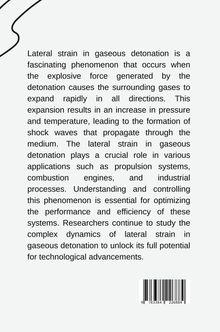Parkar: Lateral Strain: Key to Detonation Control, Kartoniert / Broschiert
Lateral Strain: Key to Detonation Control
Buch
lieferbar innerhalb 2-3 Wochen
(soweit verfügbar beim Lieferanten)
(soweit verfügbar beim Lieferanten)
Aktueller Preis: EUR 26,49
- Verlag:
- tredition, 05/2024
- Einband:
- Kartoniert / Broschiert, Paperback
- Sprache:
- Englisch
- ISBN-13:
- 9783384226884
- Artikelnummer:
- 11863996
- Umfang:
- 96 Seiten
- Gewicht:
- 177 g
- Maße:
- 234 x 155 mm
- Stärke:
- 8 mm
- Erscheinungstermin:
- 13.5.2024
- Hinweis
-
Achtung: Artikel ist nicht in deutscher Sprache!
Klappentext
Detonation waves are self-sustained supersonic combustion waves [1]. These waves areled by a shock, which compresses the fresh reactive media to a much higher temperature
and pressure for rapid reaction [1]. The tremendous reaction heat release occurring behind
the shock in return energizes the propagation process. As such, this closely coupled
shock-reaction complex self-sustains. Detonation waves can be sustained in a variety of
energetic media including reactive gases. The large overpressures generated behind gaseous
detonations make them attractive and useful for developing propulsion systems [2], such
as rotating detonation engines (RDEs) [3, 4] and pulse detonation engines (PDEs) [5, 6].
These applications require reliable control of the accurate ignition and stable propagation
of a detonation wave. Likewise, for safety applications [7, 8], it is also desirable to have the
predictability for the eventual initiation of a detonation wave and for its propagation limits
when different mitigation strategies are used [9]. Therefore, realizing all these practical
purposes requires predictive capability of detonation behavior.
Detonations in gases usually propagate with lateral strain. For example, in confined
geometries of small size, such as narrow channels or tubes, detonations are subject to
significant losses induced by boundary layers, which act as a mass sink and result in flow
divergence in reaction zones, thereby giving rise to lateral strain impacting the detonation
propagation [10]; while in geometries of varying cross-section areas or curved channels, as
typically seen in PDE pre-detonator tubes and RDE combustors, detonations are curved
with the flow also diverging after passing the leading front [11 13]. These lateral strain
rates are generally known to decrease the detonation speed and its propagation limit [10,
11, 13 17]. Thus, in order to achieve the practical purposes of either utilizing or avoiding
detonations, the effect of such lateral strain rates on detonation dynamics, e. g., detonation
propagation speed and its failure limit, needs to be quantified for revealing their influencing
mechanism. This, however, is still poorly understood and not well treated, since the highly
unsteady nature of the well-known multi-dimensional structures of detonations greatly
complicate the efforts.
Anmerkungen:
Bitte beachten Sie, dass auch wir der Preisbindung unterliegen und kurzfristige Preiserhöhungen oder -senkungen an Sie weitergeben müssen.
Mehr von Parkar
-
ParkarGender Gap: HIV & Young WomenBuchAktueller Preis: EUR 26,49
-
ParkarFrom Ancient Roads to Modern Highways: The Science of Concrete DurabilityBuchAktueller Preis: EUR 26,69
-
ParkarFrom Discovery to Cure: The Early Days of Physics in RadiologyBuchAktueller Preis: EUR 26,10
-
ParkarUnited We Sense: How Cars Talk to Each Other for Enhanced PerceptionBuchAktueller Preis: EUR 28,39

Parkar
Lateral Strain: Key to Detonation Control
Aktueller Preis: EUR 26,49






